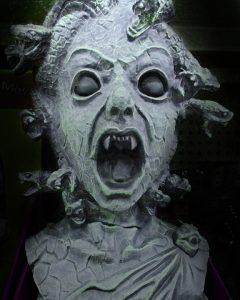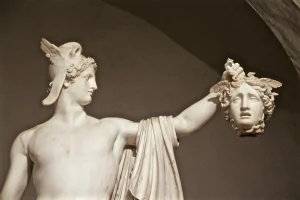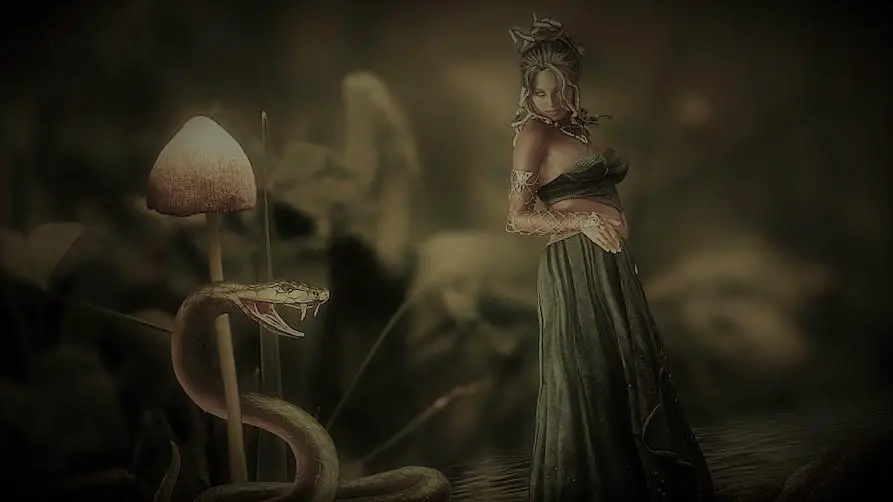Share the Lore!
By: Alex Postrado
The Most Famous Gorgon From Greek Mythology
Who doesn’t know about Medusa?
The monstrous creature from Greek mythology, who has snakes for hair and can turn anyone into stone with just a single glance.
It is likely that most of us have already heard of her. And that is largely thanks to the countless renderings of both her and her lore in art, music, writings, and film — stretching from ancient times and up to the modern-day.
Greek carvers and vase-painters of antiquity have pictured Medusa in their art in two contrasting ways: Medusa as a hideous Gorgon and Medusa as a beautiful maiden.
Around the Renaissance, pieces like Leonardo da Vinci’s lost painting Medusa and Benvenuto Cellini’s bronze sculpture Perseus with the Head of Medusa breathed new interpretations into people’s prevailing perception of the famous Gorgon.
And from there, sprang up manifold depictions of Medusa over the years and often in different lights — as seen in Ray Harryhausen’s stop-motion animation Clash of the Titans, Chris Columbus’s 2010 film Percy Jackson & the Olympians: The Lightning Thief, and interestingly, even in fashion company Versace’s iconic logo.
This varying portrayal, however, had people confused for years as to what Medusa really is — a villain or a victim of her own story?

Despite that, though, one thing remains certain:
There is a lot that we can learn just by knowing the lore of the snake-haired monster.
Who is Medusa?
Nowadays, there is no doubt that the name Medusa is often deemed synonymous — or at least closely associated — with the word “monster“.
If you are paying enough attention, you would immediately notice that I — for one — am guilty of that.
And for the most part, this is due to the fact that that specific connotation has been ingrained in many of us since time immemorial.
Basically, we “know” that Medusa is scary and horrific — sometimes, even in spite of not remembering the exact details of the classical myth.
So, to straighten it all out, we will go back to ancient Greece, in a time when the name Medusa — or Médousa — still mainly means “guardian” or “protectress”.

According to the myth, Medusa was among the beast-like children of marine deities Phorcys and Ceto.
She shares the qualities of two of her siblings — Stheno and Euryale. And together, the trio earned the moniker of the Gorgons.
The Gorgons were commonly described as “winged human females with living, venomous snakes in place of hair“.
But, other sources claim that Medusa did not initially look like that.
In fact, 5th century Greek poet Pindar even once alluded to Medusa’s beauty in one of his odes — a theme that was similarly explored, though in a more thorough way, by the Roman poet Ovid in his work, Metamorphoses.
As Ovid wrote, Medusa was “once a beautiful young maiden” and an avowed priestess of the goddess Athena.
A beautiful mortal and the only humanlike Gorgon — Medusa was the exception, not only among her siblings but also in the entire family — at least until Poseidon came into the picture.
According to Ovid’s poem, Poseidon was immediately captivated by Medusa’s beauty.
Though some translations of the Latin work were ambiguous, several versions imply that Poseidon forcibly slept with her in the sacred temple of Athena.
This act of desecration incurred the wrath of the Greek goddess of war and — as a result — she transformed Medusa into the vicious monster that we know today:
A Gorgon with a coil of serpents for hair, a set of fangs, bulging eyes, boar-like tusks, a forked tongue, and a deadly ability to turn people into stone.
The Story of Perseus and Medusa
The Greek hero Perseus was known to be the slayer of the cursed Gorgon.
In most stories, after being tricked by King Polydectes into killing Medusa — an effort that was, in actuality, intended to rid the King of him — Perseus heads on the quest to the rocky Sarpedon — where the Gorgon sisters dwell — complete with favors from the gods.
All in all, he received five favors:
An adamantine sword from Zeus and Hephaestus, a shiny shield from Athena, a pair of winged sandals from Hermes, a helmet of invisibility from Hades, and a special bag to safely store Medusa’s head from Hesperides.
Using the sword while looking at the reflection of the sleeping Medusa on the shield, Perseus was able to cut off the monster’s head.
Hesiod’s 8th-century Theogony recounts how from the severed neck of Medusa sprang Chrysaor and Pegasus — the Gorgon’s children with Poseidon.
And when the two remaining Gorgons were awoken by all the noises, they quickly tried to come to Medusa’s rescue.
However, it was too late.
Perseus, with his invisibility cap and winged sandals, had already fled the scene — leaving the Gorgons mourning the death of their sister.

Where is Medusa’s Head?
It is said that even when Medusa’s head was cut off from the rest of her body, it still remained potent.
When Perseus flew across northwestern Africa and got caught in a fight with Atlas, he used Medusa’s head to turn the Titan into the modern world’s Atlas Mountains.
The Red Sea likewise witnessed the retained powers of Medusa’s head when drops of its blood spilled onto seaweeds and turned them into corals.
While flying over present-day Libya, blood also dripped and — in the blink of an eye — turned into slithering serpents.
These are only a few examples of how Medusa’s abilities were preserved even after her death.
And considering that keeping it would be quite dangerous, the myth has it that Perseus eventually surrendered the head to Athena — who, then, placed it on her shield, called the Aegis.
Others, however, argue that Perseus actually buried it somewhere in the marketplace of Argos.
Did Medusa Exist?
Several scholars interpret the myth as a quasi-historical account — meaning, it is probably partly based on events that happened in the distant past.
Though, Hesiod and the Father of Tragedy, Aeschylus, asserted that Medusa actually existed and died in her island home of Sarpedon in present-day Turkey.
Over the centuries, numerous other claims were made.
But one that easily stands out is the theory that the lore of Medusa was actually inspired by the African serpent-goddess of the same name, who carried a pouch full of live snakes and the original, red-painted Gorgon mask — sporting a protruding tongue, fanged teeth, and “gruesome glaring eyes“.
Furthermore, she was said to be wearing dreadlocks. And when the Greeks saw her, they erroneously referred to her hair as snakes.

What the Lore of Medusa Teaches Us
Up to this day, the origin and existence of Medusa remain highly debated.
But, even in the days of antiquity, there were already hints that mythical creatures like Medusa were not meant to be taken in a literal sense.
They could be allegories of our past history or mirrors of our haunting realities.
In the case of Medusa, she has successfully embodied some of the world’s discomfiting truths, enduring till today.
To name a few — the patriarchal society, calling Perseus “a hero” after killing a defenseless, sleeping woman; the rape culture, persecuting Medusa instead of Poseidon; the victim-blaming tendencies symbolized by Athena; the demonization of women and female sexuality; and even the hierarchy of power, evident on Medusa’s part as a disposable pawn in Perseus’s legendary quest.
All of these make the myth of the snake-haired monster a multidimensional relic and Medusa, consequently, a villain, a victim, and a tragic heroine — all in one.
References:
Medusa - Greek mythology Medusa: The Real Story of the Snake-Haired Gorgon Medusa - World History Encyclopedia The Curse of Medusa From Greek Mythology The Timeless Myth of Medusa, a Rape Victim Turned Into a Monster Archaeologists Unearth Marble Head of Medusa at Roman Ruins in Turkey Was Medusa Real? The Real Medusa: An Afrikan Goddess Who Wore Dreadlocks Not Snakes What Depictions of Medusa Say about the Way Society Views Powerful Women The Power to Turn the Patriarchy into Stone
